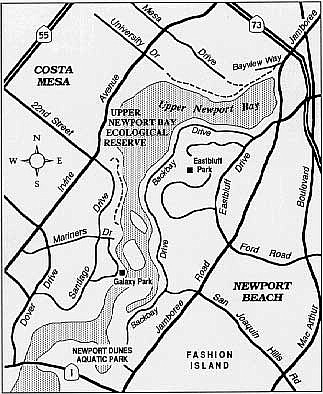 Facebook
Facebook
 X
X
 Instagram
Instagram
 TikTok
TikTok
 Youtube
Youtube
The marshland surrounding Orange County's Upper Newport Bay is but a small remnant of a wetland that once reached inland to the present city of Tustin. During the past 100,000 years or more the Santa Ana River has wandered across the surface of the Los Angeles Basin, changing course many times in response to flooding and silt deposition. Around 30,000 years ago, the river carved out the basic form of the trough-like structure now occupied by Upper Newport Bay.
The most recent natural shift in the Santa Ana River's course occurred in 1825, when a large flood redirected the flow west from Upper Newport Bay to essentially the place where it reaches the ocean today (Huntington Beach) via a wide, concrete-lined channel. For many millenniums before that, decayed marsh vegetation (peat) accumulated along the upper bay shores. This material, mixed with fine silt washed down from the surrounding slopes and bluffs, created the kind of soil conditions conducive to the self-sustaining, biologically rich wetlands we find there now.
Today, Upper Newport Bay exists in a time warp. Although it is obviously hemmed in by wide traffic arteries, high-rise buildings, residential areas, and the UC Irvine campus, coyotes and mule deer still roam its periphery. Migratory birds by the thousands use the bay marshes as a stopover or a winter home.
To appreciate the bay, many people drive, bike, jog, or walk along Backbay Drive (one-way north for cars) on the bay's east shore. A slower and surely quieter way involves meandering along the several dirt paths on the bay's north and west shores. In particular, you can try the segment of bike/hiking path that connects Bayview Way with the west segment of University Drive. At one point you pass over a massively timbered wood bridge spanning the marsh where it pinches against a steep, dry bluff. From that bridge you can view three separate tiers of vegetation. The lowest is a low-growing, salt-tolerant group of plants like pickleweed and cordgrass. Just above the reach of the tide are plants typical of the coastal uplands: wild buckwheat, mule fat, cattails, plus nonnative grasses and invasive plants like castor bean, tree tobacco, pampas grass, and fennel. Above the level of the bridge, the bluff slope supports a dense growth of native coastal sage-scrub vegetation: California sagebrush, lemonade berry, elderberry, prickly pear cactus, and coast cholla cactus.


The marshland surrounding Orange County's Upper Newport Bay is but a small remnant of a wetland that once reached inland to the present city of Tustin. During the past 100,000 years or more the Santa Ana River has wandered across the surface of the Los Angeles Basin, changing course many times in response to flooding and silt deposition. Around 30,000 years ago, the river carved out the basic form of the trough-like structure now occupied by Upper Newport Bay.
The most recent natural shift in the Santa Ana River's course occurred in 1825, when a large flood redirected the flow west from Upper Newport Bay to essentially the place where it reaches the ocean today (Huntington Beach) via a wide, concrete-lined channel. For many millenniums before that, decayed marsh vegetation (peat) accumulated along the upper bay shores. This material, mixed with fine silt washed down from the surrounding slopes and bluffs, created the kind of soil conditions conducive to the self-sustaining, biologically rich wetlands we find there now.
Today, Upper Newport Bay exists in a time warp. Although it is obviously hemmed in by wide traffic arteries, high-rise buildings, residential areas, and the UC Irvine campus, coyotes and mule deer still roam its periphery. Migratory birds by the thousands use the bay marshes as a stopover or a winter home.
To appreciate the bay, many people drive, bike, jog, or walk along Backbay Drive (one-way north for cars) on the bay's east shore. A slower and surely quieter way involves meandering along the several dirt paths on the bay's north and west shores. In particular, you can try the segment of bike/hiking path that connects Bayview Way with the west segment of University Drive. At one point you pass over a massively timbered wood bridge spanning the marsh where it pinches against a steep, dry bluff. From that bridge you can view three separate tiers of vegetation. The lowest is a low-growing, salt-tolerant group of plants like pickleweed and cordgrass. Just above the reach of the tide are plants typical of the coastal uplands: wild buckwheat, mule fat, cattails, plus nonnative grasses and invasive plants like castor bean, tree tobacco, pampas grass, and fennel. Above the level of the bridge, the bluff slope supports a dense growth of native coastal sage-scrub vegetation: California sagebrush, lemonade berry, elderberry, prickly pear cactus, and coast cholla cactus.
